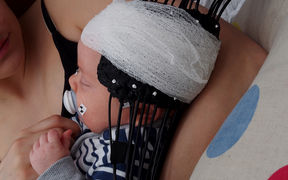Near-infrared spectroscopy and imaging group (NIRS)

Near-infrared spectroscopy (NIRS) is a method which takes advantage of the different absorption spectra of oxygenated and deoxygenated hemoglobin (HbO2 and HbR) in a relatively transparent part of the optical spectrum between red and infrared wavelengths (“optical window of tissue” from 650nm to 900nm) to estimate the concentrations (or changes in) of these chromophores based on (changes in) attenuation at selected wavelengths and the measured mean time-of-flight of the photons (or phase shift in intensity modulated systems) through the tissue. Imaging techniques based on NIRS are known as diffuse optical imaging (DOI) or diffuse optical tomography (DOT). Applications of NIRS and DOT include monitoring of tissue hemoglobin concentration and oxygen saturation in intensive care and during surgery, functional imaging of the brain, and imaging of cancer.
The near-infrared spectroscopy and imaging (NIRSI) group at NBE is developing frequency domain instrumentation for High-Density Diffuse Optical Tomography (HD-DOT) primarily for neuroimaging applications. Methods for the use of anatomical priors are also studied. In brain research, the NIRSI group's focus is in functional imaging of infants and small children. The group also researches the application of HD-DOT together with other neuroimaging modalities (such as MEG and EEG) in order to study the relationship between synchronous electrical activity of neurons and the vascular response, as well as cortical reactivity (with TMS).
Collaborators
- BioMag Laboratory, HUS Medical Imaging Center, Helsinki University Central Hospital
- FinnBrain research project, University of Turku
- Department of Clinical Neurophysiology, Hospital for Children and Adolescents, Helsinki University Central Hospital
- Department of Applied Physics, University of Eastern Finland
- Departments of Computer Science and Medical Physics, University College London
Members
Expectant mothers’ pregnancy-related anxiety may alter how infant brains respond to sad speech
Study shows correlation between mothers’ self-reported pregnancy-related anxiety, and babies’ blood flow to brain areas responsible for emotional responses when listening to sad speech







